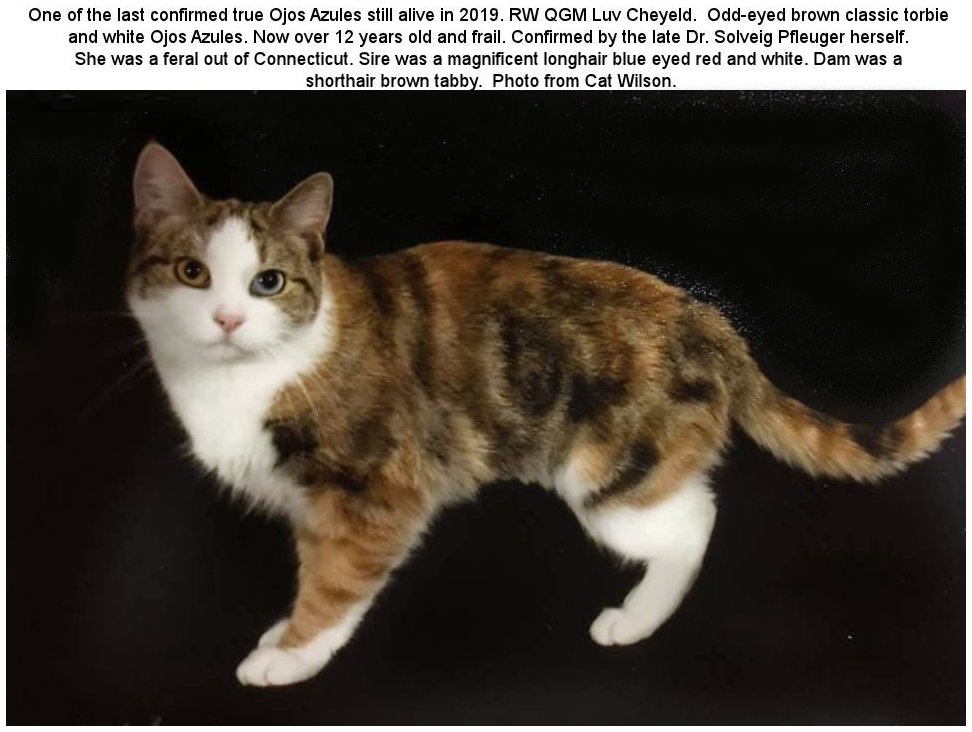
BLUE-EYED BREEDS - AMERICAN OJOS AZULES
AMERICAN OJOS AZULES (CONSIDERED EXTINCT)

Cats with vivid blue eyes were discovered in New Mexico among feral cat populations in the 1980s. In 1984, a blue-eyed tortoiseshell named "Cornflower" was bred to non-blue-eyed males resulting in litters of blue-eyed kittens. This showed the trait to be dominant. The breed was named "Ojos Azules," this being Spanish for 'Blue Eyes'.
Foundation female "Cornflower" (tortoiseshell) was found in an animal shelter in New Mexico by Annie Gass who brought her to the attention of TICA'S chief geneticist, Dr Solveig Pflueger. Cornflower had been found in a feral colony, she was a very dark tortoiseshell, predominantly black with only a few orange streaks, a small white throat locket and a couple of white toes on each hind foot, and brilliant blue eyes. When bred to unrelated males, the kittens inherited this eye colour. Quite a few of her descendants had partial heterochromia (dichromia) - both blue and either green or amber in the same eye, which was a trait peculiar to this particular mutation. During the 1990s, breeders worked to develop the Ojos Azules breed. TICA recognized the Ojos Azules as a breed in 1991 but it remained a rare breed with only 10 known individuals in 1992. The gene that caused the blue-eyed trait was found to be more complicated than a straightforward autosomal dominant. Breeding was slow because of small litters and the risk of deformities.
All of Cornflower's descendants had a distinct appearance: wide-set eyes, distinct cheekbones and plump whisker pads. They often had white tail-tips regardless of their coat colour. Several Ojos Azules were odd-eyed, which was accepted in the standard to ensure diversity and because homozygous kittens had cranial deformities, white fur, a small curled tail and they died in the womb. The cranial deformities except they were described as similar to those seen in "double merle" dogs and this led Solveig to try to investigate the gene without breeding any further kittens. When the gene is heterozygous, these lethal genetic mutations do not occur. This means it is undesirable to mate two blue-eyed Ojos Azules together. The deformities can be avoided by breeding a blue-eyed cat with a non-blue-eyed cat. This produces a litter with approximately 50% blue-eyed kittens and 50% non-blue-eyed kittens.
For comparison, merle in dogs is an autosomal, incomplete dominant mutation causing mosaic fur and blue or odd eyes. In dogs it is a mutation in the region of CFA10 that contains the SILV(aka PMEL) gene. Merle dogs (heterozygotes and homozygotes) can show a wide range of hearing and visual abnormalities similar to human Waardenburg syndrome. To complicate matters, the merle gene can vary in size (repetitive DNA), with the pattern depending on the size of the merle gene, and different cells can have different size merle genes. Double merle in dogs causes defects such as deafness and blindness; deformed, tiny or absent eyeballs; 'starburst' pupil, where the pupil appears to have spiky projections and there is light-sensitivity. They have a high degree of white, hence the gene is also called "lethal white." The stillborn homozygous Ojos Azules kittens also had white fur and one heterozygous male had light sensitivity and problems contracting the pupils.
Cornflower's daughter "Los Nuevos Iris Polychrome" (Polly) had eyes that were sapphire blue, patched and flecked with gold. Polly's daughter "Margaree's Billie" (Billie) was a red mackerel tabby with deep amber eyes but she had the facial features of an Ojos Azules. When bred to a non-Ojos Azules cat she produced four kittens, three blue-eyed and one odd-eyed, proving the theory that some genetically blue/odd-eyed cats did not exhibit the blue eyes. In the more recent blue-eyed Russian cats this is known as "latent" blue eyes (equivalent to ""cryptic merle" in dogs). Although a dominant gene cannot be "carried" it seems that the dominant trait is not always expressed (perhaps because these are all "white spotting" genes and the white spots need to be around the eyes in order to get blue eyes).
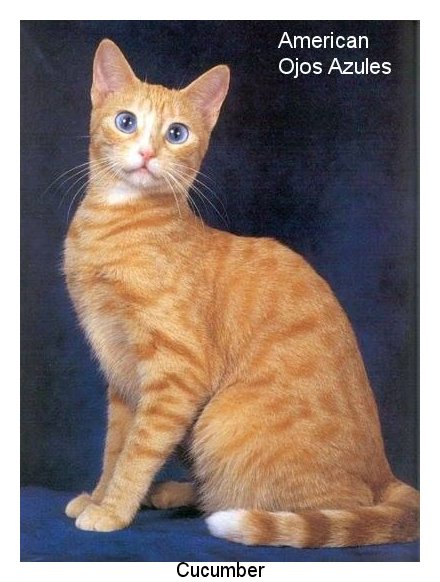
Orange eyed Billie was a non-standard Ojos Azules and could not be exhibited, but she was useful to the breeding program because she was genetically blue-eyed. Solveig kept Billie's kittens, but it was around this time that breeders became aware of the problem of breeding Ojos Azules cats to each other, regardless of their eye colour. The limited breeding data found that 9.5% of non-standard Ojos Azules (orange eyed "latents") also had birth defects. Some breeders left the breeding programme at that point because there was an unacceptably high risk of producing deformed kittens and because of the number of non-blue-eyed cats that would be produced when avoiding homozygous kittens.
Breeders could avoid the lethal defects by only breeding an Ojos Azules cat to cats of other breeds, for example a non-pedigree Domestic Shorthair with a similar facial type (because an Ojos Azules is more than just a blue-eyed cat). The resulting outcross litter should be 50% blue eyed cats and 50% not blue eyed. This was commercially and ethically non-viable because around half the kittens would need to find pet homes every time and pet-buyers would want the novel blue-eyed cats. The distinctive facial conformation was likely to be lost over just a few generations. Less scrupulous breeders would ignore a safe breeding methodology and would breed blue/odd-eyed cats together to ensure a high percentage of blue-eyed offspring, many of which would have physical deformities.
The Ojos Azules was an incredibly beautiful and friendly cats. Cornflower, Cucumber and their kittens liked water. A single longhaired red and white male, "Jeepers Creepers," was fearful and timid, but he had a problem with contracting pupils and may have been visually impaired. Visual impairment was not found in any other Ojos Azules. While blue-eyed cats turn up at random in the USA, these are unrelated to Cornflower's line and are not Ojos Azules breed the Ojos Azules was also characterised by its conformation.
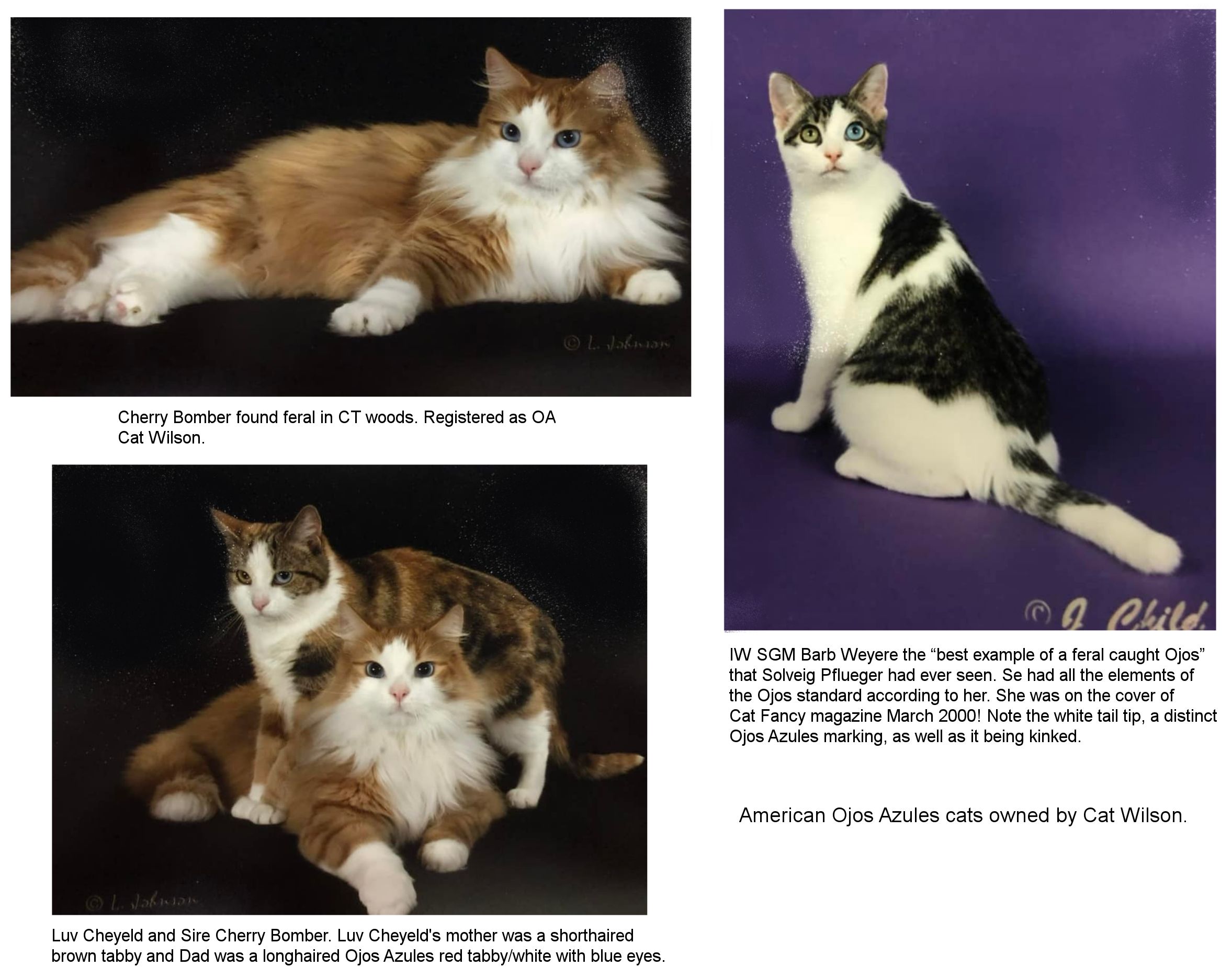
Unlike the blue eyes seen in white cats, some bicolours and colourpointed cats, the Ojos Azules gene was not linked to a particular fur colour or pattern. It also produced a deeper shade of blue than in colourpointed cats. It was also not associated with squinting or crossed eyes (seen in some colourpointed cats) or with deafness (seen in some blue-eyed white cats). Breeders saw this as an opportunity to breed blue-eyed tabbies, blue-eyed solid black cats etc. One indicator of the presence of the Ojos Azules gene was a flattened tail-tip. Unfortunately, the gene was also linked to birth defects; kittens inheriting two copies of the gene being deformed or stillborn. It wasn't clear if the deformities were caused by the Ojos Azules mutation itself or by an adjacent or linked gene. Solveig Pflueger investigated these issues and small-scale breeding then resumed in the hope of breeding Ojos Azules without the lethal genetic defects.
The blue colour is described as having depth (hue) greater than that seen in a Siamese. Regardless of the causal mutation, blue eye colour in cats is due to the absence of melanin in the iris The depth of colour is due to polygenetic variations and many show cats (Siamese, blue-eyed whites) have equally deep blue eyes. The contrast of blue eyes against a dark or patterend coat is the main attraction.
The breed was accepted for registration by TICA in 1991 in both long-haired and short-haired varieties. By 1992, only ten Ojos Azules were registered. The breed standard was last updated in 2004. Only those cats with deep blue eyes are termed the Ojos Azules, the other cats in the breeding programme are "variants" and are important for the health of the breed. The standard says "Eye colour should be clear blue or blue-grey, not turquoise or lavender. In odd-eyes, the second eye may be gold, copper, or green. A deeper eye color is preferred.
Although the Ojos Azules (the true US OA breed) is considered extinct (in 2014 TICA returned the breed to registration only), some of Solveig Pflueger's blue-eyed cats went to Sherri Mcconnell who continues to breed them. Her cats have white spotting and cornflower-blue eyes and have not shown any health issues to date. These may be the last true Ojos Azules in existence. Many cat owners mistakenly refer to random-bred blue-eyed cat as Ojos Azules in the same way they call any colourpointed cat Siamese, but if the cats are not descendants of Cornflower they are not the Ojos Azule breed.
At the time the late Solveig Pflueger was working with the Ojos Azules, Cat Wilson had about 5 rescues that Solveig verbally verified as Ojos Azules based on meeting the breed standard, especially the white tail-tip and kinked tail. These cats were from Connecticut, Maine, and New York areas. The last remaining one of these rescues, Luv Cheyeld, who was shown as a household pet, was videotaped by Dr. Leslie Lyons for a documentary on the Ojos Azules. Cherry Bomber was too skittish for exhibition.
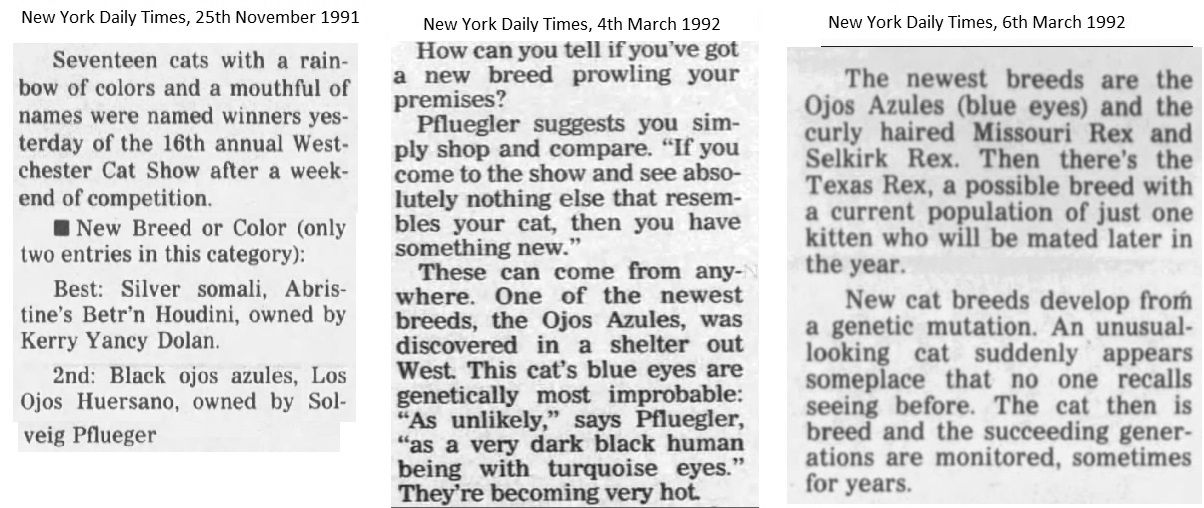
The Ojos Azules standard called for a medium-sized cat with large, round blue eyes. The neck is arched. The tail is proportionate to the cat's body. The head is somewhat triangular in shape with a slightly rounded forehead, an angular muzzle and a slight nose break. The coat is short, fine, soft, silky, and shiny without too much undercoat. All colours are allowed and white markings on the extremities (tail-tip, hind paws, and muzzle) are common, as is a sprinkling of white hairs. Because the eye colour is due to lack of melanin pigment, white markings elsewhere may be inevitable. Particolours must have a white tail tip as this is an indicator of the Ojos Azules gene, however a white locket on the chest or white spot on the belly are considered faults. Solid white is not desirable because it is visually the same as existing blue-eyed white cats. The cats bred were active, friendly, and affectionate.
Solveig always believed that someday a blue-eyed mutation would arise that was not a lethal when inherited from both parents, but most breeders stopped working with this mutation and it stopped being recognised as a breed.
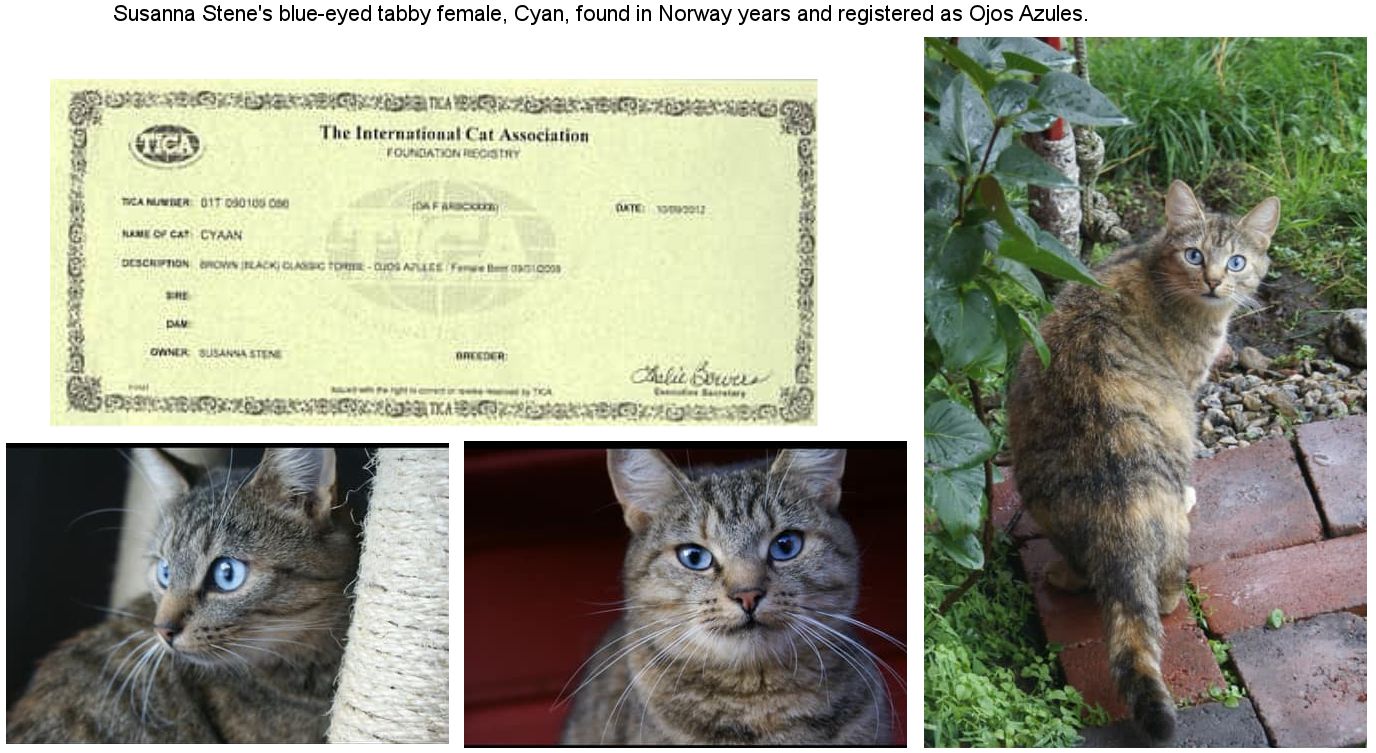
Susanna Stene had a blue-eyed tabby, Cyan, found in Norway years and registered as Ojos Azules in 2012. At the time the only way to register blue-eyed non-white/non-colourpoint cats was as Ojos Azules. Cyan came from a woman who was going to have her put down if she didn’t find a new home, and Cyan was very pregnant with 5 kittens. None of the kittens had blue eyes, but the previous owner insisted Cyan had produced 2 red kittens with blue eyes in the previous litter. Unfortunately there is no information on the father of those kittens. Susanna discussed Cyan with Solveig Pfleuger. Unfortunately, Susanna was very allergic to Cyan and offered her for free to anyone who would try breeding her to find out if the blue-eyes were a dominant or recessive trait. At that time, no-one was interested in the blue-eyed trait. Cyan was rehomed to the mother of a Norwegian celebrity.